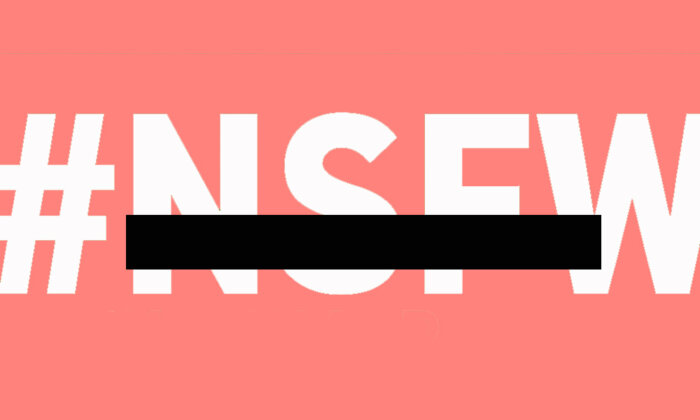The Trouble With NSFW

The hashtag #NSFW (not safe for work) acts as both a warning and an invitation. NSFW tells users, “We dare you to click on this link! And by the way, don’t do it until after work!” Unlike the specificity of movie and television advisories (“suggestive dialogue,” “sexual content”), NSFW signals, nonspecifically, sexually explicit content that ranges from nude selfies to pornography.
But Susanna Paasonen, Kylie Jarrett, and Ben Light, the authors of “NSFW: Sex, Humor, and Risk in Social Media,” argue that when applied across the board to all kinds of sexual images and formations, “the tag NSFW flattens crucial differences between them under the opaque blanket of offensiveness, riskiness, and unsafety that it connotes.” They maintain that if we are to envision social media ecologies capable of accommodating sexuality as a field of pleasure, communication, occupation, and world-making, it is crucial to resist categorical effacement of sexually suggestive and explicit content.
We asked Paasonen, Jarrett, and Light about how subjectivity and politics contribute to the nuances of what is designated “not safe for work,” how the hashtag reinforces our culture of heterosexism, and about its effects on the careers of sex workers across digital platforms.
The Editors: Invariably, the topic of “dick pics” comes up when discussing content marked #NSFW. But all bodies — and body parts — are not treated equally, as you demonstrate in the book. For example, male bodies are commonly used for humorous, gross-out content while female bodies are objectified for pornographic consumption. How else does the NSFW tag reflect heterosexism, and how does this relate to other interactions online?

The Authors: There is a very binary, heterosexist division concerning what bodies, and which parts of them, are seen as “sexy” and hence what is considered “NSFW” and needing policing. For example, image recognition software is developed to recognize bits of female bodies (and, in particular, those of white and young women) as NSFW; Tumblr banned “female-presenting nipples;” and Facebook of course has been battling displays of female breasts throughout its history, but topless images of men have never been subject to governance. These different designations as gross or titillating reflect and reproduce traditional gender and sexual norms and their troubling politics. The book also digs into sexism and online misogyny at some length when talking about forms of online labor (of the non-sexual kind) and how it turns unsafe. One of our central aims is to shift discussions concerning safety from sexual content to issues of consent and agency more broadly. A dick pic, for example, may come across as gross and offensive to some but it can equally amuse, bemuse, or sexually arouse. It can appear from virtually thin air or be connected to playful flirtation with someone very specific. Considering all this in a default framework of normative conceptions of heterosexual desire doesn’t quite cut it.
The Editors: Hunter Moore, creator of the revenge-porn website “Is Anyone Up?,” came under heavy criticism for the distribution of non-consensual content. Yet, despite its problematic format, the website generated enough monthly ad revenue for Moore to quit his job. How can we govern safe, consensual NSFW content without employing the tricky boundaries of surveillance that defines sex as the inherent problem?
The Authors: We are very much concerned with consent: who consents to what content being available to whom, and so forth. This is where ethical discussions concerning sexual representations and exchanges need to start rather than in rigid taxonomies based on a puritanical idea of what is “normal.” The DIY generation of NSFW content is mundane, widespread, and we’d be hard-pressed indeed to label it as a problem as such. The concern lies in the shaming attached to nude selfies — or, in the case of revenge porn, to their use as weapons of humiliation and blackmail. The questions as to why “NSFW” is so concerned with sex over violence or hate, for example, and how risk becomes inextricably tied in with sex by default may seem simple but are actually rather complex. One very practical way forward is for us all to continue to educate ourselves and others about sex, gender, and sexuality, how it operates in society, and the diversity and complexity of this for different groups of people at various stages in their lives.
A dick pic may come across as gross and offensive to some but it can equally amuse, bemuse, or sexually arouse.
The Editors: You mention the controversy over Illma Gore’s painting of a nude Donald Trump — that, despite concealing his genitalia, the image was removed from Facebook and the artist was accused of violating eBay’s service policy on nudity. In what ways do subjectivity and politics also contribute to the nuances of what is designated “not safe for work”?
The Authors: It is likely that Gore’s portrait was flagged by offended users, and that this happened multiple times on more than one platform. Whether these users were offended by the image per se or its implicit politics is not clear. The boundaries of offensive content are porous at best and Facebook, for example, tends to filter more rather than less in the name of a very particular definition of safety and community standards. The content policies and standards articulated, by necessity, are ephemeral and allow plenty of room for interpretation. But from our analysis (and personal experiences being banned for trying to share material for this book), on Facebook these standards tend to be particularly conservative about sexual content.
The politics and impacts of having political content banned are more complex. Technically, public status should make people easier targets for critique and satire and there certainly isn’t anything in community standards to suggest otherwise. The Trump “micropenis” portrait was a provocation, but it was also a very successful one, not least because of its NSFW status. Recurrent news of Gore being banned and the image removed circulated broadly an added to the project’s overall visibility. Having your content flagged as NSFW can also attach an extra frisson to the image and thus, ironically, ensure its greater circulation. This is a well-known maneuver associated with media historically. For example, in 1983, the U.K. band Frankie Goes to Hollywood’s release of the sexually provocative single “Relax” was accompanied with advertising in the U.K. press which led to it being banned on BBC Radio and on the BBC TV show, “Top of the Pops,” for some time, while simultaneously reaching number one in the U.K. Charts. These ongoing examples of strategies and tactics viz NSFW content illustrate the importance of considering how agency is wielded by ‘all sides,’ with significance for how we might understand the circulation of contemporary online political content such as online petitions, hate speech, and fake news.
The Editors: Another interesting issue you bring up with this tag is how it affects the careers of sex workers across digital platforms. Such obstacles include locked or deleted Google Drive files, Patreon’s refusal to support pornographic channels, and Microsoft’s prohibition of nudity on Skype. How are sex workers and companies addressing this problem that labels sex as “not safe for work” when it is, in fact, their work?
The Authors: Sex workers, in general, have little say in any of this. Data giants articulate their own policies (where sex and porn are mostly framed as problematic, offensive, and best removed) while the U.S. FOSTA/SESTA bills in particular have given rise to serious legal limitations for platforms in connection with commercial sex. Patreon used to be central in the economy of amateur and micro porn, yet the bills forced a change to this policy, just as it has forced platforms to close down sex worker ads and discussion forums on sex work safety. Sex workers, though, do continue to work politically against such laws and to organize and provide support online. Working outside U.S. law, Uglymugs is one such example, which allows U.K. and Irish sex workers to share information and support resources, including the generation of bad dates lists. Sex workers are very active in challenging and circumventing policies that impact their work.
One very practical way forward is for us all to continue to educate ourselves and others about sex, gender, and sexuality, how it operates in society, and the diversity and complexity of this for different groups of people at various stages in their lives.
The Editors: Tumblr recently did a massive purge of anything they deemed “explicit content.” A lot of users are unhappy with their profiles being policed in this manner, especially when arguably tame content — like a bare shoulder — can be flagged as NSFW. Given how quickly information can spread across the Internet, do you think it’s necessary to be cautious and implement these algorithms despite their flaws, or is there a more pragmatic approach?
The Authors: The main rationale behind Tumblr’s content ban was to have it available through the Google Play and App Store that do not allow for sexually explicit content. Tumblr had been having degrees of trouble with child porn, though, and not enough had been done to weed it out (which is ironic, in a way, since effective image recognition tools are available for this and broadly used). In response, they abruptly went the other way, filtering anything from images of sea life to ones with Donald Duck reading bedtime stories to his nephews, or black women posing fully dressed. Most importantly, the diverse sexual and gender-nonconforming communities that had thrived on Tumblr suddenly found themselves ousted and their archives inaccessible. The decision has made no sense financially as Tumblr’s value has since plummeted parallel to the drop in its user base. Ironically, NSFW content was making the site more economically secure. The recent history of Tumblr exemplifies the arguments of our book really well as the ban centered on a view of sexuality as lacking in value but, at the same time, revealed just how important it is to the flows of attention that comprise the digital economy.
Susanna Paasonen is Professor of Media Studies at the University of Turku, Finland, and the author or co-author of several books, including “Carnal Resonance: Affect and Online Pornography” and “Who’s Laughing Now: Feminist Tactics in Social Media.”
Kylie Jarrett is Head of the Department of Media Studies at Maynooth University, Ireland, and author of “Feminism, Labour and Digital Media: The Digital Housewife.”
Ben Light is Professor of Digital Society at the University of Salford, U.K., and the author of “Disconnecting with Social Networking Sites.”
